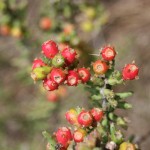Tasajillo, Turkey Pear, Christmas Cholla
Cylindropuntia leptocaulis (DC.) F.M. Knuth (syn. Opuntia leptocaulis DC.)
Cactaceae (Cactus family)
Description
Tasajillo has cylindric, jointed stems in which most of the individual segments are 1 inch or less in length. A member of the Cactus family, the plant has a general brushy appearance and usually grows to less than 5 ft or 1.5 m tall. Tasajillo leaves are tiny; they appear only briefly at each cluster of spines when new segments emerge. The plant produces small, inconspicuous, greenish flowers. Bloom time occurs from April to August. The fruit is red, fleshy, globe-shaped, and less than an inch long. The spines are white, slender, and measure from 0.5 to 2 inches long. Tasajillo often reaches the greatest densities along fence lines or under trees, where the seeds are transported by birds. This plant typically spreads by seed, which is consumed by wildlife.Habitat
Tasajillo is most abundant on sandy loam and clay loam soils and is often found in association with Honey Mesquite. Its native distribution includes Texas, Arizona, New Mexico, and Oklahoma. Native habitats include mesas, valleys, flats, and arid environments. Tasajillo grows from 1,000 to 5,000 ft or 305 to 1,524 m in elevation.Images
Plant Characteristics
Flower Color: Green, Yellow
Seed Type: Fruit/Berry
Duration: Perennial
Stem Texture: Prickly, Spiny, or Thorny
Growth Habit: Succulent/Cactus
Season: Evergreen
Distribution
 : 01 - Pineywoods, 02 - Gulf Prairies and Marshes, 03 - Post Oak Savannah, 04 - Blackland Prairies, 05 - Cross Timbers and Prairies, 06 - South Texas Plains, 07 - Edwards Plateau, 08 - Rolling Plains, 09 - High Plains, 10 - Trans-Pecos
: 01 - Pineywoods, 02 - Gulf Prairies and Marshes, 03 - Post Oak Savannah, 04 - Blackland Prairies, 05 - Cross Timbers and Prairies, 06 - South Texas Plains, 07 - Edwards Plateau, 08 - Rolling Plains, 09 - High Plains, 10 - Trans-Pecos
Distributions
Distribution refers to the ecological region in Texas that a plant has been found. You can also view a clickable map.
Book: Brush and Weeds of Texas Rangelands (B-6208)
Collection: Brush and Weeds







